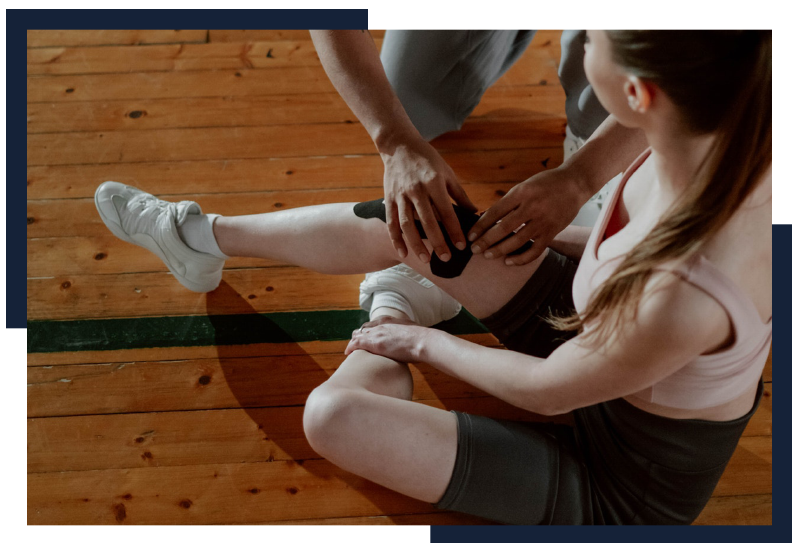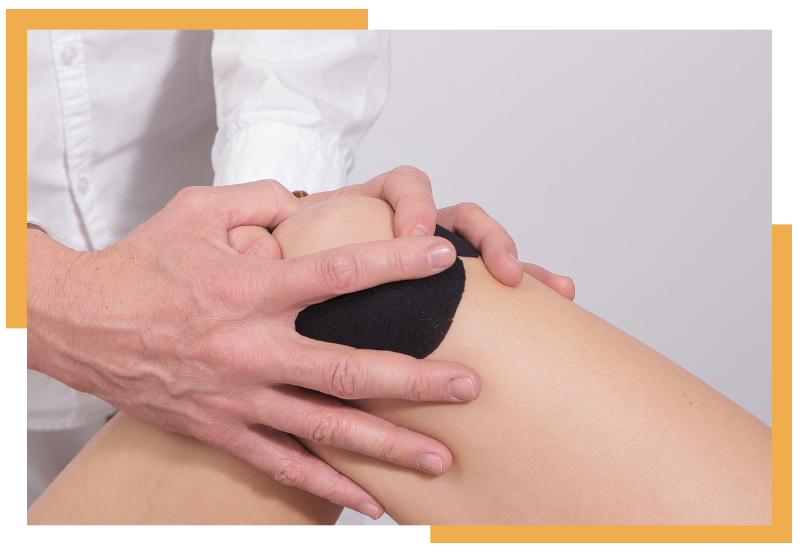Physical Therapy for Knee
Do you have a knee injury? Physical therapy can alleviate knee pain and help you gain more independence in your mobility and daily activities.

Types of Knee Injuries
Knee injuries are common. The injuries can involve sprains, fractures, strains, dislocations, tears, or any other form. Twisting or bending applied to the knee can cause damage. A direct blow from sports or an accident can also cause an injury. The most common knee injuries are:
- Anterior cruciate ligament (ACL) injury
- Arthritis
- Knee cartilage lesions
- Meniscus tears and wears
- Knee dislocation
- Patellar Tendinitis
Overusing a knee, improper training, and sudden change in directions are factors that can lead to a severe injury. At OneRehab, we provide the best knee physical therapy to help patients strengthen the knee and regain its functionality.


Anterior Cruciate Ligament Injuries
ACL injuries refer to straining or tearing of the anterior cruciate ligament. It is one of the major knee ligaments. The injury is mostly linked to sports. However, stopping suddenly to change direction, landing, or jumping can cause an injury. Some people can feel or hear the knee pop when the injury happens. The knee swells, becoming unstable and too painful to bear a person’s weight.
Causes of ACL Injury
A ligament is a tissue connecting a bone to another. The ACL connects the femur (thighbone) to the tibia (shinbone), stabilizing the knee joint. When an injury occurs, it strains the knee.
The primary causes of the injury are:
- Slowing down suddenly as a person changes direction
- When you pivot with a firmly planted foot
- Landing badly from a jump
- Being hit directly on the knee
- Stopping suddenly
Women are more prone to an anterior cruciate ligament injury. Also, involvement in some sports predisposes one to such an injury. If a person has osteoarthritis, they can also get this injury.
Signs and Symptoms of ACL Injury
- A loud pop in the knee
- Swelling rapidly
- Losing motion range
- Inability to continue an activity due to severe pain
- Feels unstable or unable to bear one’s weight
Care and Management of Anterior Cruciate Ligament
Resting is one of the ways to manage ACL injuries. Some patients may require surgery to correct the issue. Braces can stabilize the knee, and a patient can need clutches to put the weight off the knee.
Physical therapy is one of the best ways to treat this injury. OneRehab offers premium knee dislocation physical therapy to help in care and management. We take patients through exercises to restore the full range of knee motion and increase muscle strength.
Patient Wellbeing is Our Primary Concern
Do you want a quick recovery after a knee injury? Knee therapy is an option to consider. Contact us for the services.

Arthritis
Swelling or tenderness in a person’s joints is referred to as arthritis. The most common symptoms are stiffness and pain, which become worse as a person grows old. Two types of arthritis are common, rheumatoid arthritis and osteoarthritis.
Rheumatoid arthritis is where the immune system attacks the joints from their lining. Osteoarthritis leads to the breakdown of the cartilage, the hard, slippery tissue covering the bones.
What are the Symptoms?
- A loud pop in the knee
- Swelling rapidly
- Losing motion range
- Inability to continue an activity due to severe pain
- Feels unstable or unable to bear one’s weight
What are the Causes of Arthritis?
Osteoarthritis is a result of the wear and tear of the joint’s cartilage. It can happen over many years, but some infection or injury can hasten the process. Some risk factors, such as a history of arthritis in the family, age, obesity, or previous injury, can lead to arthritis.
Treatment and Management of Arthritis
There are different medications that patients take to manage pain. Surgery can also be an option to replace damaged joints. It’s mostly common in hip and knee replacement.
Another way to manage this condition is through physical therapy for arthritis. Working with our skilled therapists helps patients strengthen the affected areas, which is crucial in treating arthritis. We also walk with our patients through the various lifestyle changes to help them manage the pain.

Knee Cartilage Lesions
Osteochondral lesions, also known as osteochondritis dissecans, mostly affects the ankle and knee. The lesions are characterized by a fracture or a tear affecting the cartilage covering one of the joint bones. Cartilages are prone to tear, wear, damage, crushing, or developing a cyst.
Causes of Knee Cartilage Lesions
- Trauma from sports
- Bending or turning the knee deeply
- Underlying bone damage
- Degeneration from osteoarthritis
- Overall tissue quality loss from aging
Symptoms
- Tenderness and pain
- Locking
- Swelling
Management and Treatment
Osteoarthritis is a result of the wear and tear of the joint’s cartilage. It can happen over many years, but some infection or injury can hasten the process. Some risk factors, such as a history of arthritis in the family, age, obesity, or previous injury, can lead to arthritis.
Therapy, which includes resting, using braces and icepacks to reduce the pain, is also recommendable. Physiotherapy for knee pain equips a patient with coping skills to live a pain-free life. Stretching and strengthening muscles manages the condition.

Meniscus Tears and Wears
A torn meniscus is a common injury affecting the knee. Activities causing forceful knee twists or rotation as you put the full weight can lead to this injury. The knee contains two C-shaped cartilages. They cushion the shinbone and the thighbone (menisci). Tearing in the meniscus leads to swelling, stiffness, and pain. It can also affect the ability to stretch out the knee.
Signs and Symptoms
- Popping sensation
- Stiffness and swelling
- Pain as you rotate or twist the knee
- Feelings of locked knees
- Challenge straightening the knee
- Knee giving way
Treatment and Management
Surgery is option doctors choose if your knee is painful or remains locked. However, initial treatment is simple, where it can entail rest, icepacks, and over the counter pain medication.
The next step is rehabilitation. Physical therapy for torn meniscus gives your muscles strength and stability. At OneRehab, we look at your condition to create a treatment program that suits your needs.
Multi-ligament Injuries (Knee Dislocation)
Knee dislocation is a rare condition that occurs as a result of violent injury to the knee. It can be from a motor accident, falling from high heights, or high-intensity sports. The injuries are serious where the main artery supplying blood to the knee can be damaged. It can lead to amputation. It can also lead to nerve damage.
Treatment and Management
Treating such an injury should be immediate. When done early, doctors can assess the best course of action. Active patients have benefited from ligaments surgical reconstruction.
Conservative treatment is mostly preferred for older patients. Knee dislocation physical therapy depends on the different structures affected. OneRehab designs treatment plans for each patient, depending on the need. Our professionals are equipped to assess your current stability and injuries; thus, creating a program to help you attain pain-free mobility.

Patellar Tendonitis/Quadriceps Tendonitis
The quadriceps tendon connects the quadriceps muscles to the patella (kneecap). It straightens your knee, helping you walk, climb stairs, or jump. Once inflammation occurs on the tendon, it is known as quadriceps tendonitis. Another name for the condition is quadriceps tendinopathy.
Symptoms of Patellar Tendonitis
- Pain
- Morning stiffness
- Weakness
- Tenderness
- Swelling
- Poor mobility
Running on hard surfaces, trauma from sports, poor posture, and walking habits are some of the factors that can cause quadriceps tendinopathy.
Treatment and Management
There are non-surgical treatment methods such as icepack, rest, elevation, and compression. Patellar tendonitis physical therapy helps patients learn how to do exercises safely to improve their condition. Our physical therapists offer tailor-made and supervised activities to safeguard a patient’s interest.

What to Expect from Knee Physical Therapy
When you seek physical therapy for your knee, there are various things you can expect during your first visit. This first session is critical as it helps confirm your diagnosis and allows the physical therapist to design the best treatment. During the first visit, the PT will conduct an in-depth interview to acquire all the necessary information. They will determine the history of the condition. Factors that aggravate the problem, and also look at your past medical history contributing to the condition.
Once our knee rehab physical therapist has this information, they proceed to do a physical evaluation. The examination will consist of the following:
Evaluating Gait
Gait evaluation is an assessment of how you walk. Before designing physical therapy exercises for knee pain, we first determine your motion. Our physical therapists are well-trained to notice the slightest changes around your knee during all the walking phases.
Special Tests
The therapists can also conduct specific maneuvers around the knee which help determine the problem and its extent. It allows the PT to know which areas to focus on during the therapy.
Measure Strength
One of the causes of knee pain is weak muscles. There are several muscular attachments around the knee. When you go for therapy for knee pain, the therapist can measure strength to determine imbalance or muscle weakness causing the pain.
Swelling Measurements/ Girth
If you have an injury in your knee leading to swelling around the knee joint, the therapists can measure the swelling. It helps in administering direct treatment for the problem.
Palpation
Before knee therapy, evaluation can involve using hands to check for any abnormalities. The therapist will touch various knee structures to assess if a certain area has abnormalities or it is sensitive to touch.
ROM or Range of Motion
How well does your knee bend or stretch? It is what is known as the range of motion. When you go for an evaluation, the physical therapist can observe you stretch or bend the knee to determine the ROM. They can also use special measuring equipment to determine the extent of the problem.

Physical Therapy for Knee Pain
Once you have gone through physical evaluation and goal setting, the therapist will determine the best physical therapy for knee pain. If you want results, it is good for you to be engaged and active throughout the treatment. Often, the PT designs physical therapy exercises for the knee, which helps improve mobility and strengthen the knee.
There are at-home exercises that you may also need to do to achieve quick recovery. Some of these exercises include:
- Straight leg raises and quad sets
- Hip strengthening exercises such as bridge and squats.
- Short arc quads
- Balance exercises
- Wall squats
- Lower extremity stretches such as heel and calf stretch.
- Step-ups
- Single leg dips
To avoid re-injury, the physical therapists also advise you on how to do the exercises and the frequency. When you visit our clinic, we also monitor your progress. Additionally, we can include the following:
- Electric stimulation
- Applying heat or ice
- Joint mobilization
- Soft tissue massage
- Kinesiology taping
Whether you are looking for physical therapy for knee replacement or any other condition, it is good to get a personalized treatment plan. A well-designed therapy plan focuses on improving your condition and alleviating knee pain.
OneRehab
1761 International Pkwy Suite 135, Richardson, TX 75081, United States
Email Us
info@onerehab.com
Call Us
972 845 7875
Working Hours
M - F 7:00 AM – 7:00 PM
Sat 8:00 AM – 2:00 PM


